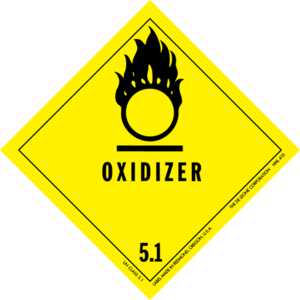Oxidizing agent facts for kids
An oxidizing agent is a special kind of chemical. Think of it as a chemical that helps other chemicals change. It can do this in two main ways.
Sometimes, an oxidizing agent works by giving away its oxygen atoms. Imagine it like a helper that shares its oxygen with another chemical. When it gives away oxygen, it helps the other chemical to "oxidize."
Another way an oxidizing agent works is by taking electrons from another chemical. Electrons are tiny parts of atoms. When an oxidizing agent takes electrons, it causes the other chemical to "lose" electrons, which is also a form of oxidation.
Contents
How Oxidizing Agents Work
Oxidizing agents are important in many chemical reactions. They cause other substances to lose electrons or gain oxygen. This process is called oxidation.
Giving Away Oxygen Atoms
One way an oxidizing agent works is by releasing oxygen atoms. For example, a chemical called potassium chlorate (KClO3) has oxygen in it. When it reacts with a reducing agent, like powdered aluminum metal, it gives its oxygen to the aluminum.
After this happens, the potassium chlorate changes into potassium chloride (KCl). The aluminum, which gained the oxygen, becomes oxidized.
Accepting Electrons
Another way an oxidizing agent works is by accepting electrons from another chemical. When an oxidizing agent takes electrons, it changes its own oxidation state.
For example, potassium permanganate has an oxidation state of +7. In an acid solution, it can gain 5 electrons. When it does this, it changes into a manganese compound with an oxidation state of +2.
Most oxidizing agents that accept electrons also contain oxygen. However, not all of them do. For instance, fluorine (F2) is known as the most powerful oxidizing agent. It does not have any oxygen atoms. When fluorine acts as an oxidizing agent, it gains an electron. Its oxidation state changes from 0 to -1.
Common Examples of Oxidizing Agents
Here are some common examples of chemicals that act as oxidizing agents:
Related Pages
See also
 In Spanish: Oxidante para niños
In Spanish: Oxidante para niños


